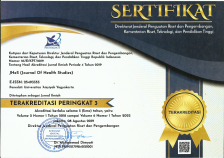The effectiveness of family-centered maternity care education on attitudes and behaviours of pregnant women
DOI:
https://doi.org/10.31101/jkk.3707Abstract views 666 times
Keywords:
stunting, attitude, behavior, family centered maternity careAbstract
Downloads
References
Abdillah, S. (2022). The Effect of Maternal and Child Factors on Stunting in Children Under Five Years in Rural Indonesia. KnE Life Sciences. https://doi.org/10.18502/kls.v7i2.10382
Anjani, R. D. (2021). Kebutuhan Gizi Ibu Hamil pada Masa Pandemi Covid-19. Jurnal Pangan Dan Gizi, 11(1), 42–49. DOI: https://doi.org/10.26714/jpg.11.1.2021.42-49
Beal, T., Tumilowicz, A., Sutrisna, A., Izwardy, D., & Neufeld, L. M. (2018). A Review of Child Stunting Determinants in Indonesia. In Maternal and Child Nutrition. https://doi.org/10.1111/mcn.12617
Dewi, A. P. S. (2022). Faktor-Faktor yang Mempengaruhi Kejadian Stunting pada Anak Balita. Jurnal Ilmu Keperawatan Dan Kebidanan, 13, 549–555.
Ecenroad, D., & Zwelling, E. (2000). A Journal to Family-Centered Maternity Care. MCN The American Journal of Maternal Child Nursing. https://doi.org/10.1097/00005721-200007000-00004
Ekayanthi, N. W. D., & Suryani, P. (2019). Edukasi Gizi pada Ibu Hamil Mencegah Stunting pada Kelas Ibu Hamil. Jurnal Kesehatan. https://doi.org/10.26630/jk.v10i3.1389
Fabusoro, O. K., & Mejia, L. A. (2021). Nutrition in HIV-Infected Infants and Children: Current Knowledge, Existing Challenges, and New Dietary Management Opportunities. In Advances in Nutrition. https://doi.org/10.1093/advances/nmaa163
Huriah, T., & Nurjannah, N. (2020). Risk Factors of Stunting in Developing Countries: A Scoping Review. Open Access Macedonian Journal of Medical Sciences. https://doi.org/10.3889/oamjms.2020.4466
Kemenkes, 2018. (2018). Kementrian Kesehatan 2018. Science as Culture. https://layanandata.kemkes.go.id/katalog-data/riskesdas/ketersediaan-data/riskesdas-2018
Linda Richter. (2016). Economies Grow When Early Childhood Development is a Priority. Mail & Guardian. https://theconversation.com/economies-grow-when-early-childhood-development-is-a-priority-69660
Liu, Y., Li, T., Guo, N., Jiang, H., Li, Y., Xu, C., & Yao, X. (2021). Women’s Experience and Satisfaction with Midwife-led Maternity Care: a Cross-Sectional Survey in China. BMC Pregnancy and Childbirth. https://doi.org/10.1186/s12884-021-03638-3
Lundgren, I., Smith, V., Nilsson, C., Vehvilainen-Julkunen, K., Nicoletti, J., Devane, D., Bernloehr, A., van Limbeek, E., Lalor, J., & Begley, C. (2015). Clinician-Centred Interventions to Increase Vaginal Birth After Caesarean Section (VBAC): A Systematic Review. BMC Pregnancy and Childbirth. https://doi.org/10.1186/s12884-015-0441-3
Mayasari, S. I., Suhita, B. M., & Indasah. (2018). The Effectiveness of Family Centered Maternity Care (FCMC) Education to Increase The Independence of Pospartum Mother. Health Notoins. DOI: https://doi.org/10.33846/hn.v2i5.205
Notoatmodjo, S., 2014, Promosi Kesehatan dan Perilaku Kesehatan. Jakarta:Rineka Cipta.
Rahmayanti, N. M. (2023). Pengembangan E-Modul Pembelajaran Berbasis Flipbook Pada Kompetensi Dasar Menerapkan Teknik Kerja Aseptis Di Smkn 1 Kuningan. Jurnal Pendidikan, 14(1), 34–47. https://jp.ejournal.unri.ac.id/index.php/JP/index. DOI: http://dx.doi.org/10.31258/jp.14.1.34-47
Rahut, D. B., Mishra, R., & Bera, S. (2024). Geospatial and Environmental Determinants of Stunting, Wasting and Underweight: Empirical Evidence from Rural South and Southeast Asia. Nutrition. https://doi.org/10.1016/j.nut.2023.112346
Rosa & Shalahuddin, M. (2011). Rekayasa Perangkat Lunak Terstruktur dan Berorientasi Objek. Modul. Bandung.
Saleh, A., Syahrul, S., Hadju, V., Andriani, I., & Restika, I. (2021). Role of Maternal in Preventing Stunting: a Systematic Review. Gaceta Sanitaria. https://doi.org/10.1016/j.gaceta.2021.10.087
Shariff, F. O., Prameswari, K. A. S., & Carolia, I. (2023). The Influence of Education by Using 5J Pregnancy Nutrition Guidebook for The Prevention of Fetal Growth Restriction and Maternal Nutritional Sufficiency. Malahayati International Journal of Nursing and Health Science. https://doi.org/10.33024/minh.v6i4.12820
Sudhinaraset, M., Landrian, A., Golub, G. M., Cotter, S. Y., & Afulani, P. A. (2021). Person-Centered Maternity Care and Postnatal Health: Associations With Maternal and Newborn Health Outcomes. AJOG Global Reports. https://doi.org/10.1016/j.xagr.2021.100005
Sukmawati, S., Hermayanti, Y., Nurhakim, F., DA, I. A., & Mediani, H. S. (2021). Edukasi Pada Ibu Hamil, Keluarga dan Kader Posyandu Tentang Pencegahan Stunting. Dharmakarya. https://doi.org/10.24198/dharmakarya.v10i4.33400
Sutarto, Mayasari, D., & Indriyani, R. (2018). Stunting, Faktor Resiko dan Pencegahanya. Fossil Behavior Compendium. 5, 540–545. https://doi.org/10.1201/9781439810590-c34
Vaivada, T., Akseer, N., Akseer, S., Somaskandan, A., Stefopulos, M., & Bhutta, Z. A. (2020). Stunting in Childhood: An Overview of Global Burden, Trends, Determinants, and Drivers of Decline. In American Journal of Clinical Nutrition. https://doi.org/10.1093/ajcn/nqaa159
Wati, K., Kartini, A., & Rahfiludin, M. Z. (2022). Determinant Factors: Literature Review Study on Stunting Incidence in Toddlers. The International Journal of Health, Education and Social. DOI: https://doi.org/10.1234/ijhes.v5i2.223
West, J., Syafiq, A., Crookston, B., Bennett, C., Hasan, M. R., Dearden, K., Linehan, M., Hall, C., & Torres, S. (2018). Stunting-Related Knowledge: Exploring Sources of and Factors Associated with Accessing Stunting-Related Knowledge among Mothers in Rural Indonesia. Health. https://doi.org/10.4236/health.2018.109096
Downloads
Published
How to Cite
Issue
Section
License
Copyright (c) 2024 Jurnal Kebidanan dan Keperawatan Aisyiyah

This work is licensed under a Creative Commons Attribution-ShareAlike 4.0 International License.
With the receipt of the article by the Jurnal Kebidanan dan Keperawatan Aisyiyah Editorial Board and the decision to be published, then the copyright regarding the article will be diverted to Jurnal Kebidanan dan Keperawatan Aisyiyah. Universitas 'Aisyiyah Yogyakarta as the publisher of Jurnal Kebidanan dan Keperawatan Aisyiyah hold the copyright regarding all the published articles in this journal.
Jurnal Kebidanan dan Keperawatan Aisyiyah is licensed under a Creative Commons Attribution-ShareAlike 4.0 International License.




















